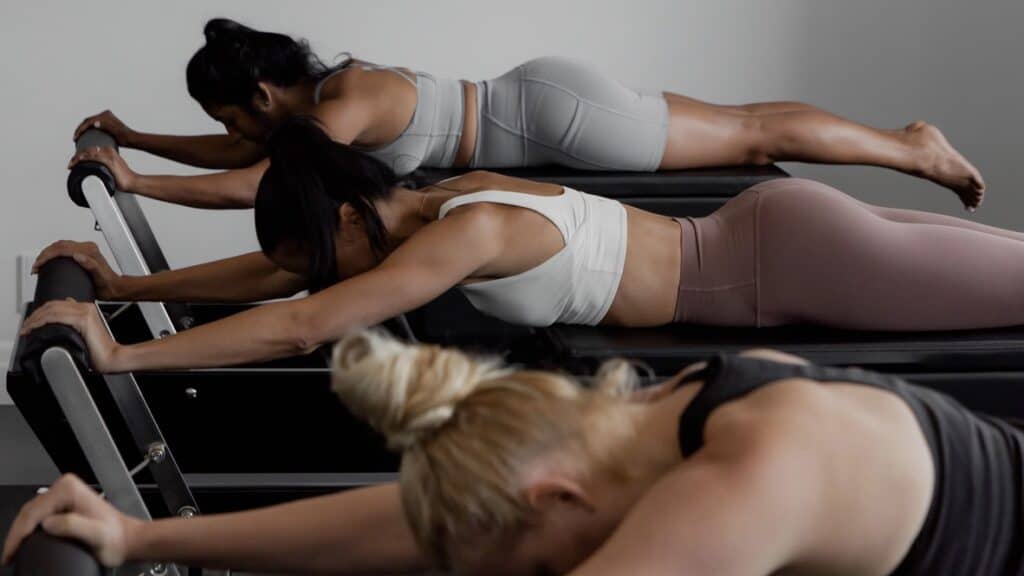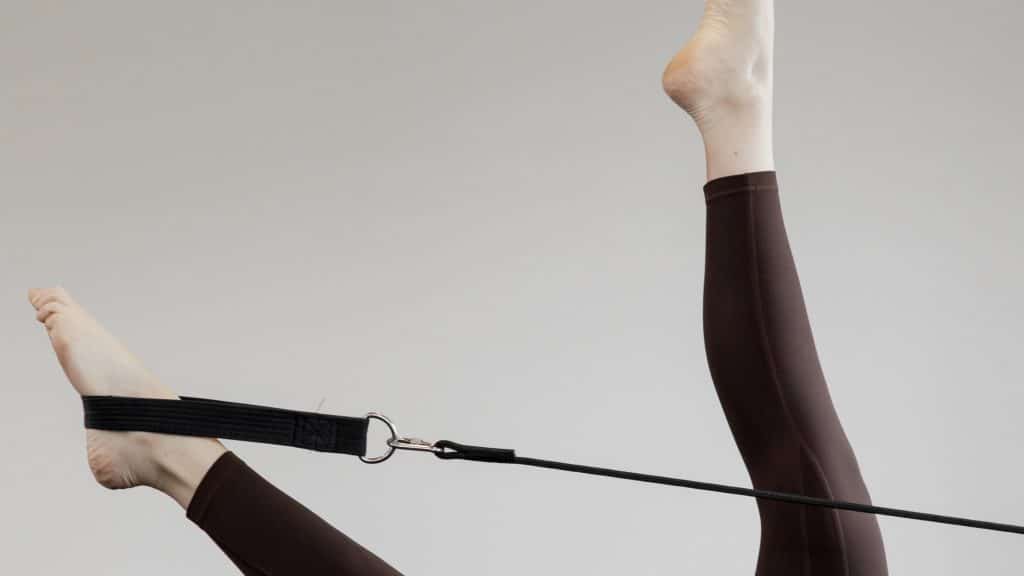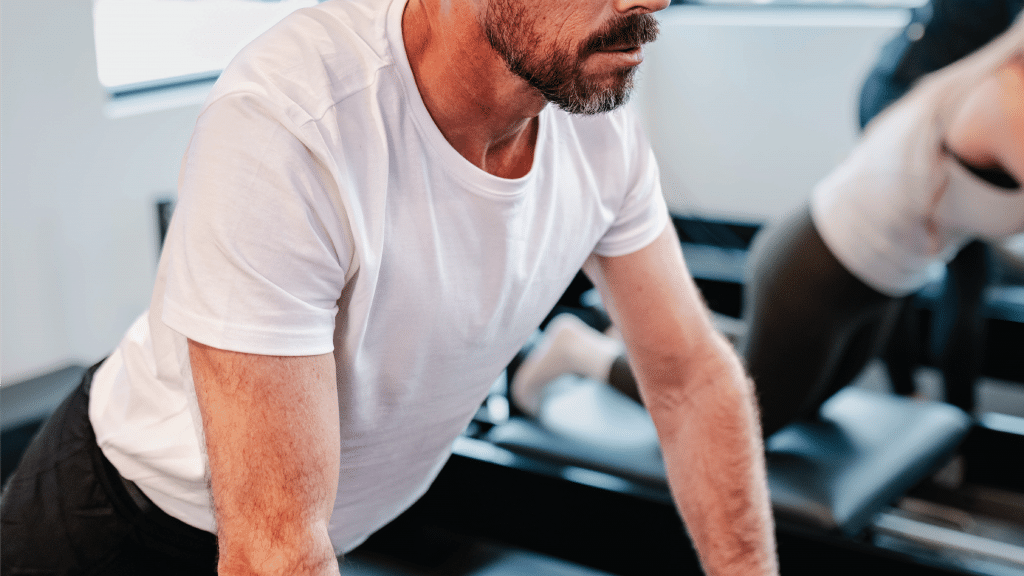For each Pilates movement, there is a breath in or out that accompanies that movement. There is also a specific technique for breathing that should be used when performing the exercises.
The main muscles that we focus on in Pilates that are involved in breathing are the diaphragm and oblique muscles.
Diaphragm
The diaphragm is an important structure, as it separates the thoracic and abdominal cavities.
The diaphragm contracts to facilitate inhalation – air is breathed in, and the abdomen rises slightly. If a person uses mostly their diaphragm for breathing and not their intercostal muscles and other muscles, then the abdomen will protrude greatly each time they inhale, rather than the ribcage expanding.
Breathing Technique
In Pilates, we have a specific breathing technique pattern designed to aid the movements and muscle activations for each exercise.
When performing Pilates breathing:
- INHALE through the nose, directing the breath into the sides of the ribs (expanding the ribs laterally)
- EXHALE through the mouth, closing the rib cage down and in
- Perform a normal inhalation (not an exaggerated, deep breath in) and a slow, forceful exhalation
INHALE through the nose, directing the breath into the sides of the ribs (expanding the ribs laterally)

EXHALE through the mouth, closing the rib cage down and in

The Theory Behind Pilates Breathing Technique
There are a number of reasons why this breathing technique is used in Pilates.
It facilitates correct muscle activation, and increases the safety of the exercises.
The reason why it is important to focus on directing the breath into the sides of the ribs (rather than the lower stomach) is that this helps to keep the abdominals activated when performing exercises. If you direct the breathing lower down into the stomach, the abdomen expands/sticks out which makes sustaining an abdominal contraction very difficult and leaves the lower back unprotected throughout the inhalation.
Another reason why we direct the breath into the sides of the ribs is to prevent shallow breathing into the upper chest, which causes the neck and shoulder muscles to tense.
Research has shown that the pelvic floor is easier to activate whilst inhaling. This is the reason why, for most exercises, the breathing is to INHALE and tighten the T-Zone. The pelvic floor contraction encourages the transversus abdominis and deep core muscles.
As you exhale, the transversus abdominis and obliques contract to increase intra-abdominal pressure and stabilise the spine. Research shows the transversus abdominus is one of the major contributing muscles recruited during a forceful exhalation, along with the obliques (Misuri et al, 1997).
Inhaling to tighten the T-Zone then exhaling to draw the ribs toward the hips assists with the correct recruitment order of the core stabilising muscles following The Centring Principle (pelvic floor, transversus abdominis, then obliques).
When inhaling, it is important to avoid taking a large, deep breath in because this can cause the thoracic spine (the upper and middle back) to extend and the abdomen to protrude, losing the abdominal muscle activation.
The reason why the breath out occurs through the mouth is to allow for a more forceful exhalation. A slow, forceful exhalation enhances the transversus abdominis (TA) and oblique activation. That being said, if the exhalation is too fast or forceful, it can cause the ribcage to depress too much or cause a bearing down effect or strain on the pelvic floor, causing the pelvic floor to deactivate.
It is important to avoid holding the breath throughout the effort of an exercise as this places an increased strain on the cardiovascular system.
Ribcage Position When Breathing
It is important to be aware of ribcage position when performing Pilates breathing. Often the ribcage will want to “pop out” or “flare” (move forward/open out) when performing an inhalation. This popping of the ribcage makes it very difficult for the obliques to activate to stabilise the spine.
When performing an exhalation, the role of the ribcage is to draw down toward the hips to create an oblique activation.
When lying supine, there should be a sensation of the ribcage resting gently on the floor. Make sure the base of the ribcage isn’t allowed to lift away from the floor. Gentle oblique muscle activation is required to maintain correct ribcage position.

Good Ribcage Position

Bad Ribcage Position
Applying Breath to Movement
In Pilates, we also have guidelines regarding how to apply breathing to movement when performing exercise. For example, whether a particular movement should be performed on an inhalation or exhalation.
As a general rule for a majority of exercises –
- INHALE to prepare and tighten the T-Zone
- EXHALE as the movement is performed, when maximum exertion is needed, when bending forward and/or the abdominals are required to work their hardest to stabilise.
The Difference Between Pilates Breathing and Yoga Breathing
If you have attended yoga classes, it will become apparent that there are some distinct differences between yoga and Pilates breathing. This can be challenging to wrap your head around initially, and neither breathing pattern is wrong or right, as both methods are using the breath for a specific purpose.
Here are some of the basic elements of Pilates breathing compared with yoga breathing
- Pilates focuses on the exhalation for the effort of most exercises, as this aids in the activation of the abdominal muscles. In Pilates, it is extremely important to have these muscles activated at all times. The breathing pattern makes this possible.
- Pilates breathing uses a normal breath in (not a deep breath in) and directs the breath into the sides of the ribs (rather than the lower belly) in order to maintain abdominal activation
How Important Is It To Use The Correct Breathing Patterns?
As far as the breathing is concerned, correct breathing patterns are beneficial to achieving the best result from an exercise. That being said, there is a lot to think about when performing the exercises, and safety is paramount. If the breathing is too confusing when you are starting out, and your technique is suffering as a result, the most important thing is for you to get the postures, activation and movement right first, then add the breathing in afterwards.






